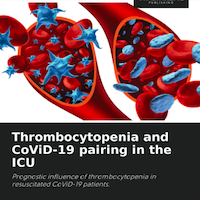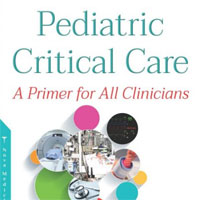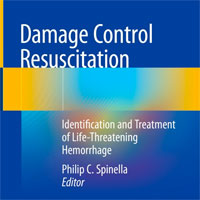Tag: resuscitation
Lactated Ringer’s a Clear Winner for Pancreatitis Resuscitation
Pancreatitis, a common and challenging condition, presents frequently in emergency departments across the country, affecting around 34 of every 100,000 adults annually. This often-severe disease is marked by inflammation... read more
Outcomes of Older Adults With Sepsis at Admission to an ICU
Our study suggests that treating older adults with therapies recommended by the Surviving Sepsis Campaign may improve outcomes in this age group, although mortality remains high for older adults with sepsis. In addition,... read more
Rethinking Energy and Protein Provision for Critically Ill Patients
In critically ill patients, we suggest that energy and protein be delivered progressively in stable or recovering patients. If a patient deteriorates, regardless of days spent in the ICU, low-dose energy and protein should... read more
A Perspective on Post-Cardiac Arrest Syndrome
This book presents a valuable new perspective on Post-Cardiac Arrest Syndrome (PCAS), which was defined as system failure following whole-body ischemia-reperfusion injuries by the 2008 International Liaison Committee on Resuscitation.... read more

Hypothermic Cardiac Arrest: Prognostic Factors for Successful Resuscitation Before Rewarming
Patients with core body temperature ... read more
Thrombocytopenia and COVID-19 pairing in the ICU: Prognostic influence of thrombocytopenia in resuscitated CoViD-19 patients
CoViD-19 is a viral zoonosis caused by the coronavirus strain (SARS-CoV-2), with acute respiratory failure being its most severe manifestation. Our aim was to determine the influence of thrombocytopenia on the severity and... read more

Pediatric Critical Care: A Primer for All Clinicians
Pediatric critical care is an emotionally and intellectually demanding field of medicine; however, it is at its core the discipline focused on saving and improving the lives of children affected by acute and chronic illnesses,... read more

Resuscitation Arterial Waveform Quantification and Outcomes in Pediatric Patients
Providing physiologically adequate CPR for pediatric single ventricle patients palliated with Bidirectional Glenn (BDG) or Fontan physiology is challenging. Only 27% of Fontan patients survived to hospital discharge with... read more
Fluid boluses and infusions in the early phase of resuscitation from septic shock and sepsis-induced hypotension
Fluid administration is the first line treatment in intensive care unit (ICU) patients with sepsis and septic shock. While fluid boluses administration can be titrated by predicting preload dependency, the amount of other... read more
Effect of Different Shock Conditions on Mesenteric Hemodynamics
The velocity parameters of SMA Doppler ultrasound such as TAMV and PSV can reflect cardiac function. The measurements of SMA RI and PI are correlated with lactate levels, having a positive predictive value for hyperlactatemia... read more
Fluid Accumulation Syndrome in Sepsis and Septic Shock
In this review, we aimed to comprehensively summarize current literature on pathophysiology, relevance, diagnosis and treatment of fluid accumulation in patients with sepsis/septic shock. Fluid accumulation syndrome (FAS)... read more
Vasoconstriction in Septic Shock
Septic shock is associated with endothelial dysfunction leading to arterial and venous dilation, alterations in regional blood flow distribution, and microcirculatory disturbances. Fluids and vasopressors are the key... read more
Fluid Boluses May Improve CRT
Several studies have validated capillary refill time (CRT) as a marker of tissue hypoperfusion, and recent guidelines recommend CRT monitoring during septic shock resuscitation. Therefore, it is relevant to further explore... read more
Fluid Personalization and Vasopressor Decisions in Early Sepsis Management
In this randomized vignette survey study of US critical care clinicians, we found that fluid volume already received was associated with the largest changes in decisions to administer additional fluids or initiate vasopressors... read more
Traumatic Major Hemorrhage in a Tertiary Trauma Center
Major traumatic hemorrhage is potentially preventable with rapid hemorrhage control and improved resuscitation techniques. The time from injury to hospital, resuscitation, diagnosis, and definitive bleeding control should... read more
Damage Control Resuscitation: Identification and Treatment of Life-Threatening Hemorrhage
This book provides a comprehensive overview of damage control resuscitation (DCR), an evidence-based approach to the resuscitation of patients with severe life-threatening hemorrhage (LTH). It focuses on both civilian... read more

ECPR for Hypothermic Refractory Cardiac Arrests in Temperate Climates
Accidental hypothermia designates an unintentional drop in body temperature below 35 °C. There is a major risk of ventricular fibrillation below 28 °C and cardiac arrest is almost inevitable below 24 °C. In such cases,... read more
Feasibility of HEMS Performed Prehospital E-CPR in Pediatric Cardiac Arrests
This case-series shows that a properly trained regular Helicopter Emergency Medical Services (HEMS) crew of only two health care professionals (doctor and flight nurse) can establish Extracorporeal-Cardiopulmonary Resuscitation... read more
Doppler Ultrasound Identified Venous Congestion in Septic Shock
Venous congestion is a pathophysiological state where high venous pressures cause organ edema and dysfunction. Venous congestion is associated with worse outcomes, particularly acute kidney injury (AKI), for critically ill... read more
Optimal Fluid Therapy for Sepsis Management in Critically Ill Adults
For a study, researchers aimed to analyze the fluid treatment in septic critically ill adults. About 20% to 30% of patients were admitted to an ICU with sepsis. In sepsis patients, investigators observed intravenous fluid... read more
Checklists and Consistency of Care After Resuscitation From IHCA
In-hospital cardiac arrest (IHCA) with the return of spontaneous circulation (ROSC) is a clinical scenario associated with potentially devastating outcomes. Our study demonstrated improved consistency in completing post-ROSC... read more
VA-ECMO in High-Risk Pulmonary Embolism
High-risk Pulmonary Embolism (PE) has an ominous prognosis and requires emergent reperfusion therapy, primarily systemic thrombolysis (ST). In deteriorating patients or with contraindications to ST, Veno-Arterial Extracorporeal... read more









